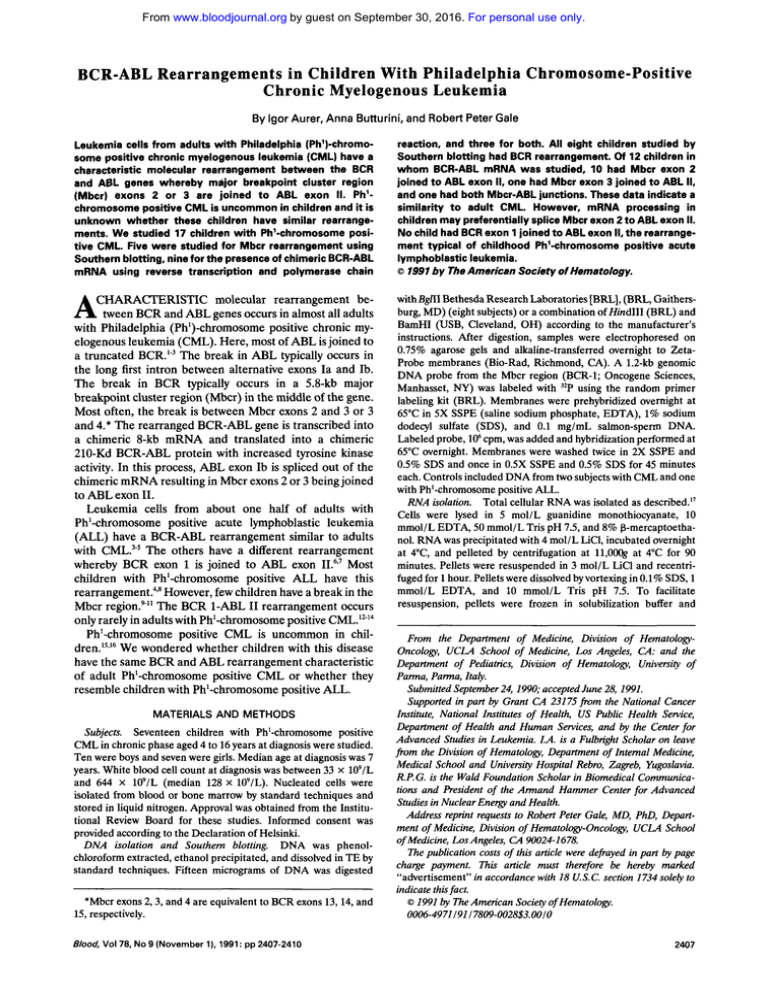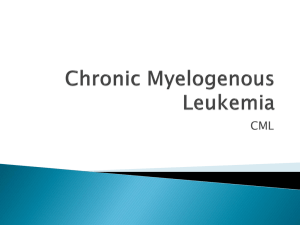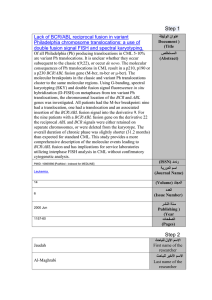
From www.bloodjournal.org by guest on September 30, 2016. For personal use only.
BCR-ABL Rearrangements in Children With Philadelphia Chromosome-Positive
Chronic Myelogenous Leukemia
By lgor Aurer, Anna Butturini, and Robert Peter Gale
Leukemia cells from adults with Philadelphia (Ph’)-chromosome positive chronic myelogenous leukemia (CML) have a
characteristic molecular rearrangement between the BCR
and ABL genes whereby major breakpoint cluster region
(Mbcr) exons 2 or 3 are joined to ABL exon II. Ph’chromosome positive CML is uncommon in children and it is
unknown whether these children have similar rearrangements. We studied 17 children with Ph’-chromosome positive CML. Five were studied for Mbcr rearrangement using
Southern blotting, nine for the presence of chimeric BCR-ABL
mRNA using reverse transcription and polymerase chain
reaction, and three for both. All eight children studied by
Southern blotting had BCR rearrangement. Of 12 children in
whom BCR-ABL mRNA was studied, 10 had Mbcr exon 2
joined to ABL exon II, one had Mbcr exon 3 joined to ABL II,
and one had both Mbcr-ABL junctions. These data indicate a
similarity to adult CML. However, mRNA processing in
children may preferentiallysplice Mbcr exon 2 to ABL exon II.
No child had BCR exon 1 joined to ABL exon II, the rearrangement typical of childhood Ph’-chromosome positive acute
lymphoblastic leukemia.
8 1991 by TheAmerican Society of Hematology.
A
withBglII Bethesda Research Laboratories [BRL], (BRL, Gaithersburg, MD) (eight subjects) or a combination of Hind111 (BRL) and
BamHI (USB, Cleveland, OH) according to the manufacturer’s
instructions. After digestion, samples were electrophoresed on
0.75% agarose gels and alkalihe-transferred overnight to ZetaProbe membranes (Bio-Rad, Richmond, CA). A 1.2-kb genomic
DNA probe from the Mbcr region (BCR-1; Oncogene Sciences,
Manhasset, NY) was labeled with 32Pusing the random primer
labeling kit (BRL). Membranes were prehybridized overnight at
65°C in 5X SSPE (saline sodium phosphate, EDTA), 1%sodium
dodecyl sulfate (SDS), and 0.1 mg/mL salmon-sperm DNA.
Labeled probe, lo6cpm, was added and hybridization performed at
65°C overnight. Membranes were washed twice in 2X SSPE and
0.5% SDS and once in 0.5X SSPE and 0.5% SDS for 45 minutes
each. Controls included DNA from two subjectswith CML and one
with Phi-chromosome positive ALL.
RNA isolation. Total cellular RNA was isolated as described.”
Cells were lysed in 5 mol/L guanidine monothiocyanate, 10
mmol/L EDTA, 50 mmol/L Tris pH 7.5, and 8% p-mercaptoethanol. RNA was precipitated with 4 mol/L LEI, incubated overnight
at 4”C, and pelleted by centrifugation at 11,OoOg at 4°C for 90
minutes. Pellets were resuspended in 3 mol/L LiCl and recentrifuged for 1hour. Pellets were dissolved byvortexing in 0.1% SDS, 1
mmol/L EDTA, and 10 mmol/L Tris pH 7.5. To facilitate
resuspension, pellets were frozen in solubilization buffer and
CHARACTERISTIC molecular rearrangement between BCR and ABL genes occurs in almost all adults
with Philadelphia (Ph’)-chromosome positive chronic myelogenous leukemia (CML). Here, most of ABL is joined to
a truncated BCR.‘” The break in ABL typically occurs in
the long first intron between alternative exons Ia and Ib.
The break in BCR typically occurs in a 5.8-kb major
breakpoint cluster region (Mbcr) in the middle of the gene.
Most often, the break is between Mbcr exons 2 and 3 or 3
and 4.* The rearranged BCR-ABL gene is transcribed into
a chimeric 8-kb mRNA and translated into a chimeric
210-Kd BCR-ABL protein with increased tyrosine kinase
activity. In this process, ABL exon Ib is spliced out of the
chimeric mRNA resulting in Mbcr exons 2 or 3 being joined
to ABL exon 11.
Leukemia cells from about one half of adults with
Phi-chromosome positive acute lymphoblastic leukemia
(ALL) have a BCR-ABL rearrangement similar to adults
with CML.”’ The others have a different rearrangement
whereby BCR exon 1 is joined to ABL exon II.6,7Most
children with Ph’-chromosome positive ALL have this
However, few children have a break in the
Mbcr region.’-” The BCR 1-ABL I1 rearrangement occurs
only rarely in adults with Ph’-chromosome positive CML.iZ-’4
Ph’-chromosome positive CML is uncommon in children.‘5.’6We wondered whether children with this disease
have the same BCR and ABL rearrangement characteristic
of adult Phi-chromosome positive CML or whether they
resemble children with Ph’-chromosome positive ALL.
MATERIALS AND METHODS
Subjects. Seventeen children with Ph’-chromosome positive
CML in chronic phase aged 4 to 16 years at diagnosiswere studied.
Ten were boys and seven were girls. Median age at diagnosiswas 7
years. White blood cell count at diagnosis was between 33 x 109/L
and 644 x 109/L (median 128 X 109/L). Nucleated cells were
isolated from blood or bone marrow by standard techniques and
stored in liquid nitrogen. Approval was obtained from the Institutional Review Board for these studies. Informed consent was
provided according to the Declaration of Helsinki.
DNA isolation and Southem blotting. DNA was phenolchloroform extracted, ethanol precipitated, and dissolved in TE by
standard techniques. Fifteen micrograms of DNA was digested
*Mbcr exons 2,3, and 4 are equivalent to BCR exons 13,14, and
15, respectively.
Blood, Vol78, No9 (November 1). 1991: pp 2407-2410
~~
~~
From the Department of Medicine, Division of HematologyOncology, UCLA School of Medicine, Los Angeles, CA: and the
Department of Pediatrics, Diviswn of Hematology, University of
Parma, Parma, Italy.
Submitted September 24,1990; accepted June 28,1991.
Supported in part by Grant CA 231 75 from the National Cancer
Institute, National Institutes of Health, US Public Health Service,
Department of Health and Human Services, and by the Center for
Advanced Studies in Leukemia. LA. is a Fulbright Scholar on leave
from the Division of Hematology, Depament of Intemal Medicine,
Medical School and University Hospital Rebro, Zagreb, Yugoslavia.
R.P.G. is the Wald Foundation Scholar in Biomedical Communications and President of the Armand Hammer Center for Advanced
Studies in Nuclear Energy and Health.
Address nprint requests to Robert Peter Gale, MD, PhD, Department of Medicine, Division of Hematology-Oncology, UCLA School
of Medicine, Los Angeles, CA 90024-1678.
The publication costs of this article were defrayed in part by page
charge payment. This article must therefore be hereby marked
“advertisement” in accordance with 18 U.S.C. section 1734 solely to
indicate this fact.
0 1991 by The American Society of Hematology.
0006-4971/91/7809-0028$3.00/0
2407
From www.bloodjournal.org by guest on September 30, 2016. For personal use only.
2408
AURER, BUTTURINI, AND GALE
vortexed while thawing. Freezing and thawing were repeated until
pellets were completely dissolved. RNA was obtained by phenolchloroform extraction and precipitation in ethanol. Samples were
dissolved in deionized sterile water and stored in liquid nitrogen.
Reverse transcription. Moloney murine leukemia virus-reverse
transcriptase (BRL) was used. ABL antisense primer, 20pmol. and
20 U of RNAsin (Promega, Madison, WI) were added and reverse
transcription performed under recommended conditions for 1 hour
in a total volume of 20 pL. Negative and positive controls were
included in each experiment. RNAs isolated from cell lines with
Mbcr 3-ARL 11 and BCR I-ABL 11 junctions were used as positive
controls.'
Polymerase chain reaction (PCR). Primers and probes were
kindly provided by Dr E. Canaani (Weizmann Institute of Science,
Rehovot, Israel). Sequence data are reported.'" Ten microliters of
the reverse transcription reaction mixture and 2.5 U of Taq DNA
polymerase (Perkin-Elmer-Cetus, Norwalk, CT) were used for
each PCR. Two amplifications were performed with each sample:
in one, primers specific for BCR 1 and ABL I1 exons were used; in
the second, primers for Mbcr 2 and ABL I1 exons were used. In the
former, only cDNA fragments with BCR 1 joined to ABL I1 are
amplified, resulting in a 190-bp product. I n the latter, cDNA
fragments with Mbcr exons 2 or 3 joined to ABL I1 are amplified;
the resulting products are 244 and 319 bp, respectively. PCR was
performed in a Perkin-Elmer PCR-machine for 30 cycles: denaturation at 95°C for 1 minute, annealing at 55°C for 30 seconds, and
elongation at 72°C for 90 seconds.
Samples amplified with BCR I-ABL 11 and Mbcr 2-ABL I1
primers were electrophoresed on separate 3% agarose gels and
alkaline-transferred overnight to Zeta-Probe membranes. Probes
were labeled with '*P using T-4 kinase (BRL). Membranes were
prehybridized for 3 hours at 55°C in 5X SSPE, 1% SDS, and 0.1
mglmL salmon-sperm DNA. Probe, 10" cpmlml, was added and
hybridization was performed overnight at 5°C below the dissociation temperature.'" Membranes were washed twice for 10 minutes
in 2X SSPE and 1% SDS at room temperature and once in 5X
SSPE, I o/o SDS at 65°C before exposure.
BCR I-ABL I1 junction specific probe was hybridized to the
BCR I-ABL 11 membrane. Mbcr 2-ABL I1 junction specific probe
was hybridized to the Mbcr 2-ABL I1 membrane. After film
exposure the membrane was stripped by washing twice in 0.2X SSC
and 0.1% SDS at 95°C for 15 minutes and rehybridized with the
Mbcr 3-ABL I1 junction specific probe.
I
*
319 bp
244bp
Fig 1. Two representative samples hybridized with the Mbcr
2-ABL II and Mbcr 3-ABL I1probes. The 319-bp band corresponds to a
junction between Mbcr exon 2 and ABL exon II, and the 244-bp band
corresponds to a junction between Mbcr exon 3 and ABL exon II.
cies, including diseases similar to chronic and acute leukemia in transfected or transgenic mice.'3,'4
There is controversy whether Ph'-chromosome positive
ALL is a distinct disease or whether some cases represent
acute phase CML where the chronic phase was undetected." In most children with Ph'-chromosome positive
ALL, BCR 1 is joined to ABL IL4.' Our results suggest that
1
2
RESULTS AND DISCUSSION
The eight children studied by Southern blotting had BCR
rearrangements. The breakpoint location was between
Mbcr exons 2 and 3 in four children where it was mapped.
In 10 of 12 children studied by PCR, the chimeric BCRABL mRNA was spliced to join Mbcr exon 2 to ABL exon
11. In one, Mbcr exon 3 was joined to ABL exon 11. In the
final child, both BCR-ABL junctions were detected indicating alternative splicing (Figs 1 and 2). No child had BCR 1
joined to ABL 11.
BCR-ABL rearrangements are probably important in the
pathogenesis of Phl-chromosome positive CML and ALL.
It is not clear whether differences between these two
diseases result from different rearrangements (BCR 1-ABL
I1 v Mbcr 2 or 3-ABL 11). BCR 1-ABL I1 is more efficient in
transforming cells in vitro than Mbcr 2 or 3-ABL II."."
Also, the former preferentially causes acute leukemia in
transgenic
while the latter causes different malignan-
Fig 2. Amplification of BCR-ABL cDNA by PCR. Bands of 319 and
244 bp in lane 1 correspond to mRNA with Mbcr 2-ABL I1 and Mbcr
3-ABL II junctions, indicating alternative RNA splicing. This subject
had an Mbcr 3-ABL II junction on Southern blotting of DNA.
From www.bloodjournal.org by guest on September 30, 2016. For personal use only.
2409
BCWABL IN CHILDHOOD CML
in children with Ph'-chromosome positive CML, Mbcr 2 or
3 are joined to ABL 11. These data indicate that in children,
Ph'-chromosome positive ALL and CML are distinct. Also,
molecular analysis distinguishes between children with
Ph'-chromosome positive ALL and those with lymphoid
acute phase of CML.
In approximately one third of adults with Ph'-chromosome positive CML, Mbcr 2 is joined to ABL 11. In the
other two thirds, Mbcr 3 is joined to ABL I?'3
Therefore,
it is interesting that almost all children with CML had the
Mbcr 2-ABL I1 junction. Whether adult cases of CML with
different BCR breakpoint locations differ clinically is controversial. Some studies suggest a longer duration of chronic
phase in persons with Mbcr 2-ABL I1 junctions than in
those with Mbcr 3-ABL I1junctions~'" but others found no
differen~e.~'.'~
In our prior review of children with CML we
found no evidence that they have a briefer chronic phase
than adults.34
In conclusion, we found that children with Ph'-chromosome positive CML have a different BCR-ABL rearrangement than those children with Ph'-chromosome positive
ALL. This rearrangement is similar to that found in adults
with CML. These data suggest a different pathogenesis of
these two diseases. Why a predominance of children with
CML had a chimeric BCR-ABL mRNA in which Mbcr
exon 2 is spliced to ABL exon I1 is unclear.
ACKNOWLEDGMENT
Drs Andrea Biondi (University of Milan), Andrea Pession
(University of Bologna), Stephen Feig (UCLA), Jerry Finkelstein,
Yung Soon Wim, and many others kindly provided subject samples.
We thank Emanuel Maidenberg for technical assistance and
Katharine Fry for typing the manuscript.
REFERENCES
1. Kurzrock R, Gutterman JU, Talpaz M: The molecular genetics of Philadelphia chromosome-positive leukemias. N Engl J Med
319:990,1988
2. Dreazen 0, Canaani E, Gale RP: Molecular biology of
chronic myelogenous leukemia. Semin Hematol25:35,1988
3. Epner DE, Koeffler HP: Molecular genetic advances in
chronic myelogenous leukemia. Ann Intern Med 113:3,1990
4. Heisterkamp N, Jenkins R, Thibodeau S, Testa JR, Weinberg
K, Groffen J: The bcr gene in Philadelphia chromosome positive
acute lymphoblastic leukemia. Blood 73:1307,1989
5. Schaefer-Rego K, Arlin Z, Shapiro LG, Mears LG, Leibowitz
D: Molecular heterogeneity of adult Philadelphia chromosomepositive acute lymphoblastic leukemia. Cancer Res 48:866,1988
6. Hermans A, Heisterkamp N, von Lindem M, van Baal S,
Meijer D, van der Plas D, Wiedemann LM, Groffen J, Bootsma D,
Gromeld G: Unique fusion of bcr and c-ab1 genes in Philadelphia
chromosome positive acute lymphoblastic leukemia. Cell 51:33,
1987
7. Fainstein E, Marcelle C, Rosner A, Canaani E, Gale RP,
Dreazen 0, Smith SD, Croce CM: A new fused transcript in
Philadelphia chromosome positive acute lymphocytic leukemia.
Nature 330386,1987
8. Bartram C R Rearrangement of the c-ab1 and bcr genes in
Ph-negative CML and Ph-positive acute leukemias. Leukemia 263,
1988
9. Dreazen 0,Klisak I, Jones G, Ho WG, Sparkes RS, Gale RP:
Multiple molecular abnormalities in Ph' chromosome positive
acute lymphoblastic leukaemia. Br J Haematol67:319,1987
10. Hooberman AL, Rubin CM, Barton KP, Westbrook C A
Detection of the Philadelphia chromosome in acute lymphoblastic
leukemia by pulsed-field gel electrophoresis. Blood 74: 1101, 1989
11. Suryanarayan K, Hunger SP, Kohler S, Carroll AJ, Crist W,
Link MP, Cleary M L Consistent involvement of the BCR gene by
9;22 breakpoints in pediatric acute leukemias. Blood 7:324,1991
12. Saglio G, Guerrasio A, Tassinari A, Ponzetto C, Zaccaria A,
Testoni P, Celso B, Rege Cambrin G, Serra A, Pegoraro L
Variability of the molecular defects corresponding to the presence
of Philadelphia chromosome in human hematologic malignancies.
Blood 72:1203,1988
13. Zaccaria A, Testoni N, Tassinari A, Celso B, Rassool F,
Saglio G, Guerrasio A, Rosti G, Tura S: Cytogenetic and molecular
studies in patients with chronic myeloid leukemia and variant
Philadelphia translocations. Cancer Genet Cytogenet 42:191, 1989
14. Selleri L, von Lindern M, Hermans A, Meijer D, Torelli G,
Grosveld G: Chronic myeloid leukemia may be associated with
several bcr-ab1 transcripts including the acute lymphoid leukemiatype 7 kb transcript. Blood 75:1146,1990
15. Linet MS: The Leukemias. Epidemiologic Aspects. New
York, NY,Oxford, 1985, p 31
16. Altman AJ: Chronic leukemias of childhood. Pediatr Clin
North Am 35:765,1988
17. Cathala G, Savouret JF, Mendez B, West BL, Karin M,
Martial JA, Baxter JD: A method for isolation of intact, translationally active ribonucleic acid. DNA 2329,1983
18. Marcelle C, Gale RP, Prokocimer M, Berrebi A, MerleBeral H, Canaani E: Analysis of BCR-ABL mRNA in chronic
myelogenous leukemia patients and identification of new BCRrelated sequence in human DNA. Genes Chromosomes Cancer
1:172,1989
19. Itakura K, Rossi JJ, Wallace RB: Synthesis and use of
synthetic oligonucleotides. Annu Rev Biochem 53:323,1984
20. McLaughlin J, Chianese E, Witte ON: Alternative forms of
the BCR-ABLoncogene have quantitatively different potencies for
stimulation of immature lymphoid cells. Mol Cell Biol9:1866,1989
21. Lug0 TG, Pendergast AM, Muller AJ, Witte ON: Tyrosine
kinase activity and transformation potency of bcr-ab1 oncogene
products. Science 247:1079,1990
22. Heisterkamp N, Jenster G, ten Hoeve J, Zovich D, Pattengale PK, Groffen J: Acute leukaemia in bcr/abl transgenic mice.
Nature 344:251,1990
23. Daley GQ, van Etten RA, Baltimore D: Induction of chronic
myelogenous leukemia in mice by the P210be"ab'gene of the
Philadelphia chromosome. Science 247:824,1990
24. Elefanty AG, Hiriharan IK, Cory S: bcr-abl, the hallmark of
chronic myeloid leukaemia in man, induces multiple haemopoietic
neoplasms in mice. EMBO J 9:1069,1990
25. Gale RP, Butturini A Ph'-chromosome positive ALL and
lymphoid acute phase of CML One or two diseases? Leuk Res
14295,1990
26. Shtivelman E, Gale RP, Dreazen 0, Berrebi A, Zaizov R,
Kubonishi I, Miyoshi I, Canaani E: bcr-ab1 RNA in patients with
chronic myelogenous leukemia. Blood 69:971,1987
27. Schaefer-Rego K, Dudek H, Popenoe D, Arlin Z, Mears JG,
Bank A, Leibowitz D: CML patients in blast crisis have breakpoints
localized to a specific region ofthe BCR. Blood 70:448,1987
From www.bloodjournal.org by guest on September 30, 2016. For personal use only.
2410
28. Shtalrid M, Talpaz M, Kunrock R, Kantarjian H, Trujillo J,
Gutterman J, Yoffe G, Blick M: Analysis of breakpoints within the
bcr gene and their correlation with the clinical course of Philadelphia-positive chronic myelogenous leukemia. Blood 72485,1988
29. Mills KI, MacKenzie ED, Bimie GD: The site of the
breakpoint within the bcr is a prognostic factor in Philadelphiapositive CML patients. Blood 721237,1988
30. Eisenberg A, Silver R, Soper L, Arlin Z, Coleman M,
Bernhardt B, Benn P: The location of breakpoints within the
breakpoint cluster region (bcr) of chromosome 22 in chronic
myeloid leukemia. Leukemia 2:642, 1988
31. Morris SW, Daniel L, Ahmed CM, Elias A, Lebowitz P:
AURER, BUTTURINI, AND GALE
Relationship of bcr breakpoint to chronic phase duration, survival,
and blast crisis lineage in chronic myelogenous leukemia patients
presenting in early chronic phase. Blood 75:2035,1990
32. Dreazen 0, Berman M, Gale RP: Molecular abnormalities
of bcr and c-ab1in chronic myelogenous leukemia associated with a
long chronic phase. Blood 71:797,1988
33. Ogawa H, Sugiyama H, Soma T, Masaoka T, Kishimoto S:
No correlation between locations of bcr breakpoints and clinical
states in Ph'-positive CML patients. Leukemia 3:492,1989
34. Marin T, Butturini A, Kantajian H, Sokol J, Mickey MR,
Gale RP: Survival of children with chronic myelogenous leukemia.
Am J Pediatr Hematol Oncol (in press)
From www.bloodjournal.org by guest on September 30, 2016. For personal use only.
1991 78: 2407-2410
BCR-ABL rearrangements in children with Philadelphia chromosomepositive chronic myelogenous leukemia
I Aurer, A Butturini and RP Gale
Updated information and services can be found at:
http://www.bloodjournal.org/content/78/9/2407.full.html
Articles on similar topics can be found in the following Blood collections
Information about reproducing this article in parts or in its entirety may be found online at:
http://www.bloodjournal.org/site/misc/rights.xhtml#repub_requests
Information about ordering reprints may be found online at:
http://www.bloodjournal.org/site/misc/rights.xhtml#reprints
Information about subscriptions and ASH membership may be found online at:
http://www.bloodjournal.org/site/subscriptions/index.xhtml
Blood (print ISSN 0006-4971, online ISSN 1528-0020), is published weekly by the American
Society of Hematology, 2021 L St, NW, Suite 900, Washington DC 20036.
Copyright 2011 by The American Society of Hematology; all rights reserved.




